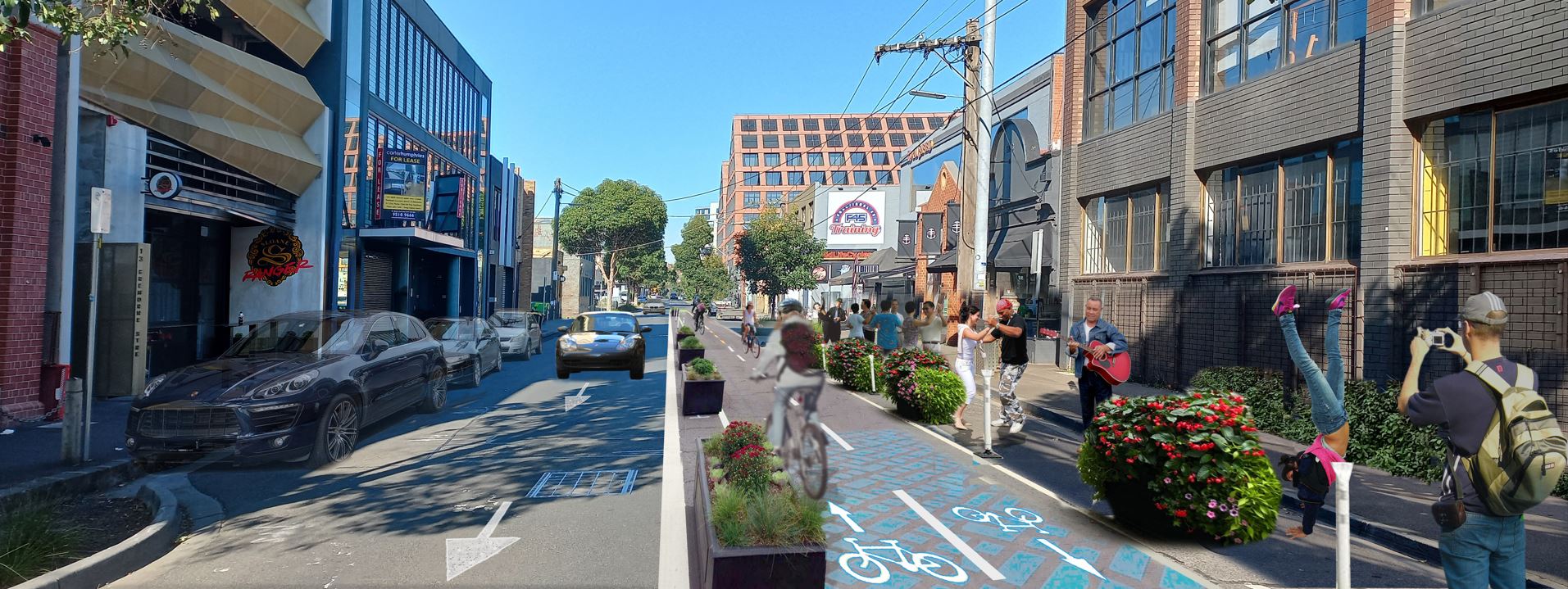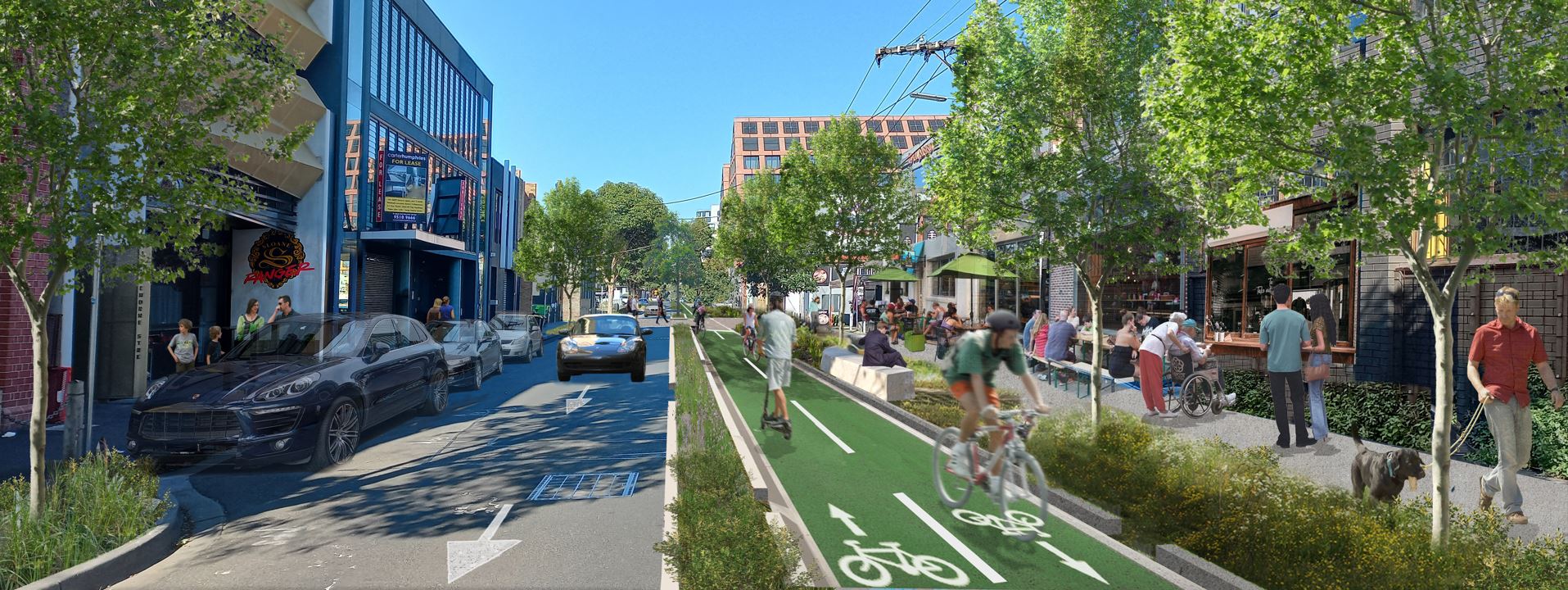
Local Councils have been trialling pop-up bike lane infrastructure across inner Melbourne suburbs to support and encourage safe cycling. The Pop-up Bike Lanes Program is temporary, allowing for routes to be adapted in line with community consultation, feedback and monitoring. The bicycle route trials are to be implemented for 12-18 months before removal or, in the case of success, remain as permanent infrastructure (VicRoads 2022).
Recently, implementation of these temporary bike lanes sparked a discussion around ways these pop-up lanes could be better implemented.
At Ratio, we strongly support the implementation and rollout of pop-up bike lanes as supportive bicycle infrastructure that play an integral role in assisting a shift towards safe and sustainable transport modes. The reallocation of road reserves from private vehicles to bicycles also allows for the facilitation of increased and improved public space for pedestrians and local businesses (through extended ‘parklet’ dining areas) and amenity for communities.
Ratio’s Transport, Planning and Urban Design teams conducted a study of our local Cremorne neighbourhood, investigating different ways of rolling out temporary bicycle infrastructure that can have improved outcomes for cyclists, pedestrians and the community.
Cremorne is an ideal candidate for bicycle infrastructure trialling due to its proximity to the city, location between inner eastern suburbs and the CBD, and characteristics of being a relatively closed-off precinct nestled between a railway line, the Yarra River, Monash Freeway and Hoddle Street.
Cremorne has been heavily revitalised from its industrial past to keep pace with its commercial future, accommodating an abundance of design studios, consultancy practices, start-ups, and larger entities, such as Seek and Kangan Institute. The neighbourhood experiences high levels of pedestrian activity for the last leg of journeys. This may be attributed to site constraints (often small and limited on-site parking provision) and proximity to train stations (Richmond Station and East Richmond Station) as well as multiple tram services along Swan Street and Church Street.
The community must be involved in the process of reallocating road space throughout the precinct and extensive community consultation should be at the forefront of any design decision.
Cremorne has limited road reserve space throughout the precinct, with numerous streets already catering to one-way traffic. There is limited capacity to create high-quality outcomes that service our overarching aims of improving public space for community and business, pedestrian movement, amenity and importantly safe and effective cyclability while maintaining two-way traffic movement on the streets.
- Brett Young, Director: Transport
We have conceptualised a ‘one-way car loop’ which will allow vehicles to continue to access the precinct whilst also allowing for the partial conversion of the road carriageway and on-street parking to be reallocated for protected bike lanes, and open space, and increased planting and green space.
The loop has been designed to provide cycling infrastructure throughout the precinct for several key reasons:
To investigate how the road reserve would be reallocated, Cremorne Street ‒ a key street in the proposed loop ‒ has been redesigned.
Cremorne Street has been chosen to explore as it is the core of Cremorne and should be a street which enhances a sense of place and belonging.
Cremorne Street currently provides one lane for traffic travelling in each direction and on-street parallel parking on both sides of the street, as shown in the image below.
Notable constraints on Cremorne Street for implementing temporary cycling infrastructure are the Water Sensitive Urban Design (WSUD) outstands which inhibit ‘quick fix’ solutions, such as the repurposing of on-street parking by limiting fixed continuous cycling infrastructure within the road carriageway or requiring cyclists to merge with traffic where WSUD’s are located.


Under interim conditions, the western carriageway and on-street parking space could be reallocated to a two-way protected cycleway, with adjacent open space, temporary planter boxes and extended footpaths.
The use of removable planter boxes as protective barriers delivers a positive impact on public amenity as opposed to the alternative yellow painted lines and bright fixed posts.
The use of the existing on-street parking can be dictated by abutting businesses, which allows for extended dining if desired, extended footpaths and potential open space for exhibitions. Consequentially, additional public space may be utilised by the community rather than servicing parked vehicles.
The implementation of bike lanes offers Cremorne an opportunity to reclaim its streets and focus on the people who live and work locally.


Ultimate conditions see the implementation of fixed infrastructure, which allows for increased functionality and amenity of the street.
Notably, it allows for the following:
It is important to show how the trial could look if successful, highlighting that pop-up lanes are not the end product.
The ultimate concept shown is purely a concept, the future design should be decided upon by the community who uses the space.


- Ariel Utz Wirnsberger, Urban Designer